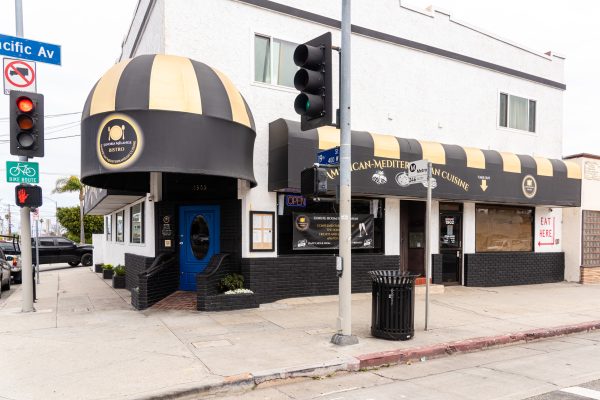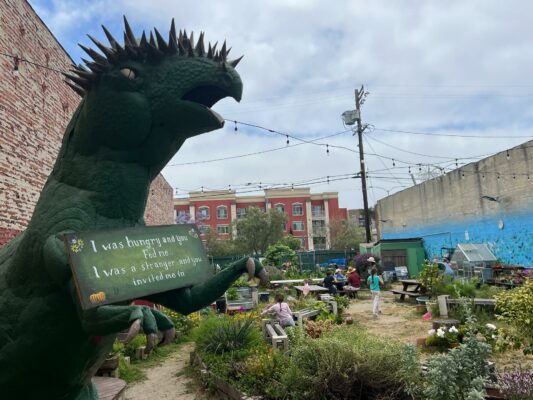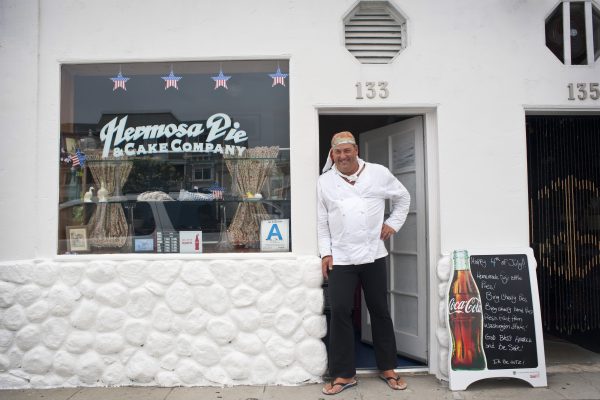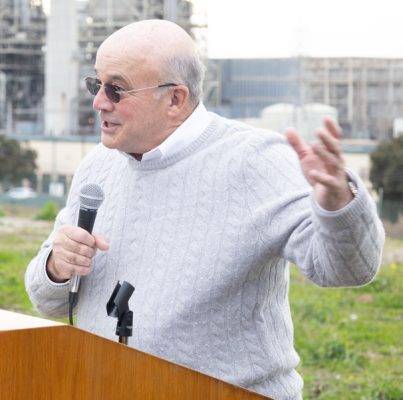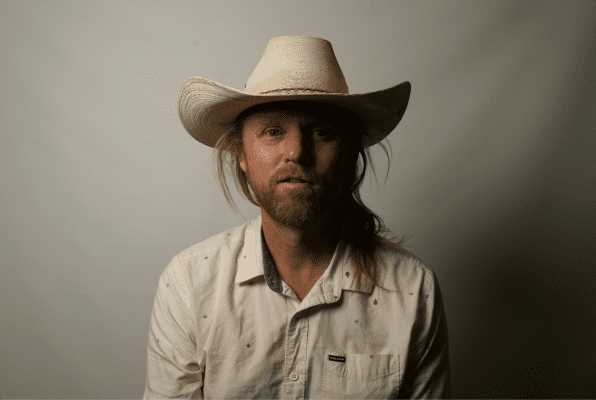
Haven’t seen it yet? There’s still time – and it’s well worth the investment.
Peter Paul Rubens (1577-1640) was among the giants of late 16th century and early 17th century art, and the Getty Center has highlighted his work on previous occasions, including “Rubens & Brueghel: A Working Friendship,” in 2006, and last year’s “Looking East: Rubens’s Encounter with Asia.” The latter show focused on a single chalk drawing whereas “Spectacular Rubens” highlights several large tapestries, even though Rubens remains best known as an action painter – although not quite in the sense that Jackson Pollock is deemed an action painter. However, if he had been a film director, Rubens might be likened to Ridley Scott or possibly Peter Jackson. In other words, a large canvas with lots going on.

Photograph at the Getty of “The Victory of Truth over Heresy” (1626-1633), woven in Brussels by Jan Raes I, Jacob Genbels II, and Jacob Fobert after designs by Peter Paul Rubens. Wool and Silk. Photo courtesy The Getty
As Alejandro Vergara notes in the catalogue for the current show, which he co-edited with Anne T. Woollett, “Rubens was a master choreographer. The positioning of limbs suggests actions – most often very expressive or even violent actions.” And Woollett herself points out: “The Eucharist series is characterized by weighty figures in action.”
That brings us to the portal of this mighty commission, which seemed just right for the large artistic appetites of the prolific Flemish master.
Down through the ages
In 2010 the Prado in Madrid undertook restorations of a group of modelli, this being six detailed sketches painted on panels that Rubens had painted in preparation for their being turned into large tapestries. Conservation was needed on the panels because the supports, which had been added sometime after the panels were painted, had begun to stretch and warp the panels, causing damage to the painted surface itself. The Getty Foundation pitched in with a grant, and that probably goes a long way to explaining why we can now see them in Los Angeles.

“The Triumph of the Church” (1626-1633), woven in Brussels by Jan Raes I after designs by Peter Paul Rubens. Wool and silk. Patrimonio Nacional, Monasterio de las Descalzas Reales, Madrid. Photo by Bruce M. White
The panels alone would have made for a small, concise show, but what sweetens the deal for all of us are the four large tapestries of the Eucharist series – of of the original 20 – that have come along for the ride, as well as related work from other museums, including the Norton Simon, LACMA, and the Getty’s own collection.
In the early 1620s, the Infanta Isabel Clara Eugenia (1566-1633), then governor-general of the Southern Netherlands (roughly where Belgium sits today), commissioned 20 large tapestries for the Monasterio de las Descalzas Reales in Madrid (that is, the Convent of the Barefoot Royals), a commission regarded as an ex-voto offering in gratitude for the victory of Spanish troops in Breda in June of 1625, although the works themselves seem to have been in the pipeline a couple of years earlier.
Rubens and the Infanta shared Habsburg religio-political ideals, and this vast project, as Woollett describes it, “envisioned a unified decorative program that would transform the austere convent church and cloister during the annual eucharistic feasts with vibrant figural compositions within illusionistic architectural frames arranged on two levels.”
Isabel’s father was Philip II of Spain, and her husband Archduke Albert, so she’d come into some money without having to moonlight as a journalist or a museum curator. The Eucharist series was the most expensive gift of Isabel’s rule, and comparable to the military budget for one month.
The tapestries were woven over the course of about eight years in two of Brussels’ most prominent workshops, Jan Raes I heading up one and Jacob Geubels II the other, with Jacob Fobert and Hans Vervoert assisting. This was the third of four tapestry series designed by Rubens, clearly the most prestigious of the four, although I’m not sure if he again worked with the same tapestry workshops.
What they were for; where did they go?

“Isabel Clara Eugenia with Magdalena Ruiz” (1585-1588), by Alonso Sánchez Coello. Oil on canvas. Museo Nacional del Prado, Madrid
The tapestries vary in size, with a few of them at least capable of covering an entire wall or maybe the inside of a two-car garage. It was Rubens’s only site-specific project even though he’d never seen the interior of the convent. Fortunately, he was sent a pretty fair description of it, complete with accurate measurements (You may remember that Jackson Pollock’s Mural for Peggy Guggenheim didn’t exactly shoehorn easily into her hallway).
The preparatory paintings and thus the tapestries embody a point of view that was based on where they were to be hung and how they would be viewed. However, things can change drastically over the course of four centuries, the point being that we don’t know exactly where all of the tapestries were hung – which isn’t to say there aren’t some pretty good estimates.
“The series was primarily intended to decorate the church of Descalzas Reales on two occasions a year,” writes Ana Garcia Sanz: “Good Friday and the Octave of Corpus Christi. Both of these focused on the exaltation of the sacrament of the Eucharist.” And so, not only were the tapestries rolled out and rolled up year after year, they were often lugged outdoors and hung up there as well.
Now, as everyone knows, sunlight loves few things better than bleaching artwork, photographs, and the spines of your favorite books. Even non-direct sunlight is damaging. The tapestries, thus, are quite faded, some are even a bit disappointing when looked at, although they must have been breathtaking to behold when first pulled from the delivery van and unrolled on the floor. Rubens’s modelli give us a good idea of just how vibrant they once were.
As for the designs themselves, they are cleverly illusionistic in that trompe l’oeil manner so prevalent during the Baroque era. As Vergara notes, “The main scenes of each tapestry take place in a feigned tapestry that hangs from fictive architecture or is placed behind the columns.” That is, we have tapestries within tapestries and the sense of architecture within architecture – all symbolic in the sense that the Eucharist is the symbolic flesh and blood of Christ.
A visual fanfare

“The Triumph of the Church” (about 1622-1625), by Peter Paul Rubens. Oil on panel. Museo Nacional del Prado, Madrid
One can only imagine how it all looked in its heyday, with a processional sense – the movement of the scenes flowing left to right – that suited the liturgy of eucharistic ceremonies. Just gaze at the work and consider how each one would have “sounded” if the scene were actualized: snorting horses, angels blowing on horns as if they were John Coltrane or Miles Davis, chariot wheels crushing infidels who cry out, the rustle and swish of garments… What a delicious ruckus!
All quite a show and not so subtly working as propaganda for the spread of Catholicism (versus Protestantism, of course). Some of us will become believers, but not so much for the power of the Church as for the power of Art.
Spectacular Rubens: The Triumph of the Eucharist is on view through January 11 at the J. Paul Getty Museum, 1200 Getty Center Drive, Los Angeles. Also on view: Drawing in the Age of Rubens. Hours, Tuesday through Friday and Sunday from 10 a.m. to 5:30 p.m., and Saturday from 10 a.m. to 9 p.m. Closed Monday. Free; parking $15. Call (310) 440-7300 or go to getty.edu.

